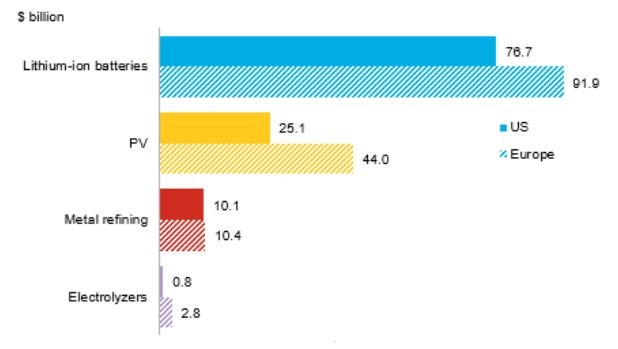This analysis is from BloombergNEF. It appeared first on the Bloomberg Terminal.
Today’s battery and solar value chains are dominated by China, but that could change if Western governments have their way. The US and EU are wielding subsidies and outright protectionism to expand domestic clean energy manufacturing. Making up lost ground will be challenging and costly, but could create more diversified, resilient global supply chains and, of course, jobs. Yet the sprint to localize marks a wrenching departure from the unfettered free trade of recent years. That shift is creating plenty of friction.
By the numbers

Upfront cost of new factories needed to meet domestic clean-energy manufacturing demand in 2030

- China’s global share of capacity for 11 segments of the PV and battery value chains tops 70%. Chinese PV manufacturers also sell from Southeast Asia, own upstream battery metal mines and control the supply of key equipment required to build new factories.
- Concentration makes supply chains vulnerable, so localization is a hedge against future risks. Policymakers also want to tap economic value as the energy transition picks up momentum.
- Shifting manufacturing has a big upfront price tag. Building the factories required for PV, battery and electrolyzer plants to meet local demand in 2030 would cost $149 billion in Europe, and $113 billion in the US. Operating costs would inflate this figure further.
- Building ecosystems matters more than factory capex. There is little expertise in running solar ingot or graphite anode factories in the West. Inputs like PV glass are lacking. A dearth of know-how and kit will be hard to tackle if Chinese investments are restricted.
- Western governments are moving, with the US leading the way. The US Inflation Reduction Act’s (IRA) theoretically limitless manufacturing credits should spur huge investments in wind, batteries and PV. For its part, the EU is spending big on making batteries and electrolyzers.
- Batteries are the sector policymakers typically keenest to localize and, post-IRA, the US provides stronger manufacturing incentives across the board. Yet localization will come at a cost and would surely slow the learning rates that continue to make clean energy cheaper.